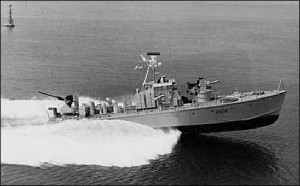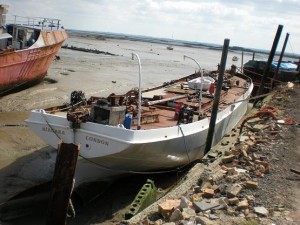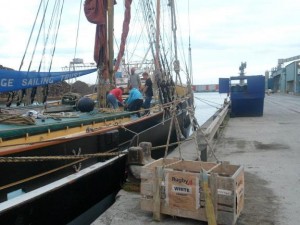
MTB Gay Archer at speed, photo from David Archer who served on a sister vessel.
I have been enjoying a nice old ‘chin-wag’ via e-mail with friend of Cambria and occasional contributor, David Rye who turns out to have his own strong connections with the MTBs we mentioned yesterday. David sent me the attached picture of the ‘Gay class’ MTB Gay Archer and attaches the following notes.
Says David, “Nice shot of 102.
I was on MTB’s in the 50’s – the Gay class, Gay Fencer actually – good job we did not have cap tallies with the names on!
The Archer is down at Watchett, N.Devon.
Fully restored – the owner sold his house to do it!
Plenty of info on the internet all about her.”
Thanks for that, David. Perhaps we should say for the benefit of younger readers, that “Gay” has only fairly recently come to have the association with same-sex relationships. Prior to the 70’s ‘gay’ just meant happy,bright, exuberant and colourful. I love an ‘at speed’ photo of an MTB. Shows that beautiful hull off to best advantage.
David has also given me some more on the ‘Stone Heaps’ discussion from a few weeks back. Hilary Halajko had mentioned that Cambria had moored there overnight and Nick Ardley had entered a comment about the location and the origin of the name (see earlier posts). David now advises us to “take a look at the link, http://bernardoconnor.org.uk/Coprolites/Suffcops/SHOTLEY.htm , which says that “The earliest evidence of coprolite diggings in Shotley was in 1858. It was included in a list of nine Suffolk villages exporting the raw material for conversion into superphosphate in factories in Ipswich and Harwich…………Apart from digging fossils another unusual occupation that employed many in the parish was described in the local trade directory, “Sea Boats are employed here in collecting stone for the manufacture of Roman Cement.” (White’s Directory 1874) This involved nodules of “septaria“, lumps of clay, which were dredged along the mouth of the estuary. Along with the local clay they formed the basis of a small cement industry. In 1871 Lucas C. King was described in the census as a “Farmer of 76 acres employing 4 labourers and 2 boys, Cement Stone Merchant employing 6 men.” This had been going on at least since the 1850s when many men described themselves as cement stone dredgers and loaders. By 1874 the Shotley Brick, Lime and Cement Works had started with Edward Gibbons as the manager. etc etc” Feel free to go off and read more.
Thanks for that, too David.
Lastly (today) I must just say that I am going on “shore leave” for a few days now and may or may not be able to post. I will actually be based on the Cambria (Ah! Sigh!) at Gravesend, finally able to see her, walk her decks and re-new my acquaintance with all her timbers and tackle, not having seen her since Dec 9th last year. A group of volunteers, including me, will have her moored alongside St Andrew’s Wharf in Gravesend and, all being well, open to the public so please do feel free to come down and say ‘Hello’ to the old girl. After all, if you’ve ever bought a Lottery ticket she is, in a sense, your barge. We are just privileged to mind her for you! Look after yourselves and I will be back posting in a short few days.


